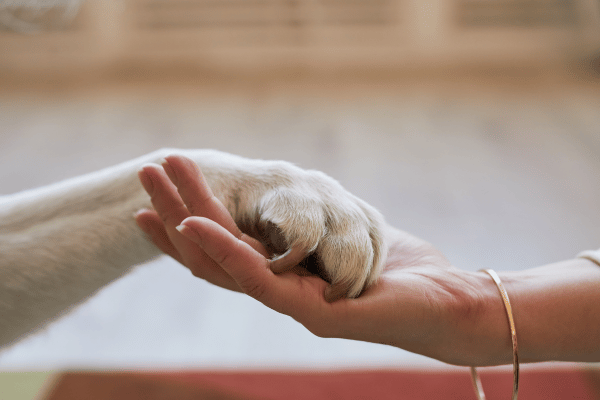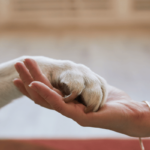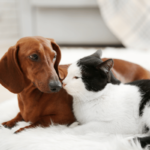Discover the essentials of Effective Pet Exercise Routines for your beloved pets. Tailor activities to enhance their health and happiness in this comprehensive guide.
Understanding Your Pet’s Exercise Needs Clearly

Understanding your pet’s exercise needs is crucial. Just like humans, pets require regular physical activity for optimal health. However, each pet is unique, and their exercise routines should reflect this. For dogs, activities might range from brisk walks to agility training, depending on their breed and age. Cats, often more independent, can enjoy interactive toys and climbing structures. Importantly, exercise not only boosts physical health but also mental well-being.
Creating a balanced exercise routine for pets involves more than just physical activity. It’s about understanding their natural behaviors and preferences. Dogs, for instance, often love games that involve fetching or chasing, which also stimulate their minds. Cats, on the other hand, might prefer solitary play with toys that mimic prey, like feathers or lasers. Integrating these activities into daily routines ensures that your pet stays engaged, healthy, and happy.
Effective Pet Exercise Routines also mean adapting to your pet’s life stage. Puppies and kittens have boundless energy and require short, frequent play sessions. Adult pets might enjoy longer, more structured activities. Senior pets, however, need gentler exercises tailored to their comfort level. Regular vet check-ups are essential to tailor these routines effectively, ensuring they align with your pet’s health status and physical capabilities, thus promoting a long, fulfilling life.
Maximizing Fun and Safety in Pet Workouts
Maximizing fun and safety during pet workouts is essential. For dogs, this might mean choosing a well-fitted harness for walks or ensuring play areas are secure. Cats often prefer indoor exercises, so creating a safe, stimulating environment is key. This includes scratch posts and safe high perches. Remember, safety also means understanding your pet’s limits. Overexertion can lead to injuries, so it’s crucial to monitor their behavior and adjust activities accordingly.
Incorporating variety in pet workouts keeps them exciting. Dogs might enjoy a mix of walks, runs, and interactive games like tug-of-war. For cats, alternating between different types of toys – like puzzle feeders and light pointers – can keep them engaged. This variety not only prevents boredom but also ensures a well-rounded exercise regime. Additionally, seasonal changes offer opportunities to introduce new activities, keeping your pet’s routine fresh and stimulating throughout the year.
Consistency is key in Effective Pet Exercise Routines. Establishing a regular schedule helps pets anticipate and look forward to their exercise time. For dogs, consistent walks and playtimes aid in behavioral training. Cats, although more independent, also benefit from a routine, as it provides a sense of security and normalcy. Consistency doesn’t mean rigidity, though. Be flexible and adjust the routine as needed, especially considering your pet’s health and environmental changes.
Balancing Exercise with Your Pet’s Health Needs
Balancing exercise with your pet’s health needs is vital. Regular physical activity is crucial, but it must align with their overall health. For instance, a dog with joint issues might benefit from swimming, a low-impact exercise. Cats with limited mobility can engage in gentle play. It’s important to consult with a veterinarian to understand any health limitations and adjust exercise routines accordingly. This ensures your pet stays active without compromising their health.
Nutrition plays a significant role in your pet’s exercise routine. A well-balanced diet fuels their energy levels, enhancing their workout performance. For active dogs, diets rich in protein and healthy fats are beneficial. Cats, obligate carnivores, require a diet high in animal protein. Always ensure they have access to fresh water, especially after exercise. Consulting a vet for dietary advice can optimize their health and complement their exercise routine effectively.
Rest and recovery are as important as the exercise itself. After a vigorous play session or walk, pets need time to relax and rejuvenate. This downtime allows their muscles to recover and prevents overexertion. Providing a comfortable resting area, whether it’s a cozy bed for your dog or a quiet corner for your cat, is essential. Also, pay attention to signs of fatigue or discomfort, as these may indicate a need for a more relaxed routine.
Effective Pet Exercise Routines Enhance Lifelong Health
Integrating Effective Pet Exercise Routines into daily life enhances lifelong health for pets. Regular exercise not only maintains physical fitness but also supports mental health. For dogs, activities like hiking or agility courses offer mental stimulation. Cats benefit from interactive play that mimics hunting behaviors. These activities keep their minds sharp and bodies agile, reducing the risk of obesity and related health issues. Remember, a healthy pet is a happy pet.
Adapting exercise routines to the changing seasons is important. In warmer months, early morning or late evening walks help avoid overheating, especially for dogs. During colder seasons, indoor play becomes more crucial for cats. Utilizing indoor obstacles or creating hide-and-seek games can be effective. Seasonal adaptation ensures that your pet remains active and engaged year-round, contributing to their overall well-being and preventing seasonal health issues.
Involving the whole family in your pet’s exercise routine can be beneficial. It not only provides variety for the pet but also strengthens the bond between pet and family members. For dogs, family hikes or group play sessions can be enjoyable. Cats might appreciate interactive toys that involve human participation. This shared activity time promotes a sense of belonging and emotional connection, enhancing the pet’s social skills and emotional stability.
Innovative Indoor Exercises for Weather-Challenged Days

Innovative indoor exercises are key for weather-challenged days. For dogs, indoor obstacle courses using household items can provide both physical and mental stimulation. Cats might enjoy chasing laser pointers or interactive toys that mimic prey. These activities keep them active and prevent boredom, especially when outdoor activities are limited. It’s important to create a safe indoor environment, removing any potential hazards, to ensure these play sessions are both fun and secure.
Training sessions can also be an effective indoor exercise. Teaching your dog new tricks or practicing obedience commands not only exercises their body but also their mind. For cats, simple training like coming when called or using puzzle feeders can be engaging. These sessions enhance their cognitive abilities and deepen the bond between pet and owner. Plus, it’s a rewarding experience to see your pet learn and grow through these activities.
Yoga or stretching exercises with your pet can be surprisingly beneficial. Some dogs may participate in ‘doga’ (dog yoga), which can be a calming and bonding experience. For cats, encouraging stretching through play or using cat towers can promote flexibility. These gentle exercises are particularly beneficial for older pets, helping to maintain their mobility and comfort. Always ensure these activities are done gently and respect your pet’s limits.
Tailoring Exercise to Different Pet Personalities
Tailoring exercise to different pet personalities is crucial. Active dogs, like Border Collies or Labradors, may thrive on high-energy activities like running or frisbee. Conversely, more laid-back breeds, such as Bulldogs, might prefer leisurely walks. Cats also have varied personalities; some may enjoy interactive play with humans, while others prefer solo activities. Understanding your pet’s unique personality and preferences ensures that their exercise routine is both enjoyable and beneficial for their mental and physical health.
Socialization is an important aspect of pet exercise, especially for dogs. Group walks or dog park visits provide opportunities for social interaction, which is vital for their emotional well-being. For cats, although generally more solitary, exposure to different environments or controlled social settings can be beneficial. This helps in building their confidence and reducing anxiety. Always ensure these social experiences are positive and gradual to avoid overwhelming your pet.
Incorporating play into exercise routines adds an element of fun. For dogs, playing fetch or tug-of-war can be both physically demanding and mentally stimulating. Cats might enjoy chasing toys or engaging in play that simulates hunting. Play is a natural way for pets to exercise, and it also strengthens the bond between pet and owner. It’s a joyful way to keep your pet active and engaged, contributing to their overall well-being.
Monitoring Pet Health During Exercise Activities
Monitoring pet health during exercise activities is essential. Observing your pet’s response to physical activity helps in identifying their comfort level and limits. For dogs, watch for signs of fatigue or overheating, especially in warmer weather. Cats, while more self-regulating, should also be monitored for any signs of distress during play. Regular vet check-ups are crucial to ensure that their exercise routine aligns with their health status, preventing potential injuries or health issues.
Adjusting exercise routines for pets with health concerns is important. For example, dogs with arthritis may require low-impact activities like swimming or gentle walks. Cats with mobility issues might benefit from shorter, more frequent play sessions. Always consult with a veterinarian to tailor exercise routines to specific health needs. This personalized approach ensures that your pet remains active and healthy, while also taking care of their specific medical conditions.
Encouraging hydration and proper nutrition post-exercise is vital. After physical activities, ensure your pet has access to clean, fresh water to prevent dehydration. For dogs, especially those engaging in intense exercise, providing a balanced meal afterwards supports muscle recovery. Cats, typically less intense in their exercise, still benefit from a nutritious meal post-play. These practices are essential for replenishing energy and maintaining overall health, making them integral parts of a comprehensive exercise routine.
Incorporating Outdoor Adventures in Pet Exercises
Incorporating outdoor adventures in pet exercises can be exhilarating. For dogs, exploring new trails or parks stimulates their senses and provides variety. Cats, typically indoor pets, can also enjoy the outdoors safely through leashed walks or enclosed patios. These experiences not only offer physical exercise but also mental stimulation. It’s important to always ensure safety, keeping your pet leashed or in a secure area, and to be mindful of weather conditions.
Seasonal activities add excitement to your pet’s exercise routine. In summer, swimming can be a great option for dogs, offering a fun way to cool down while exercising. For cats, interactive outdoor play in a secure area can be enjoyable. In winter, indoor agility courses for dogs and playful indoor hunting games for cats keep them active. Adapting to the seasons keeps your pet’s exercise routine engaging and appropriate for the weather.
Remember, the goal of outdoor adventures is to enrich your pet’s life. It’s not just about physical exercise, but also about exploring and experiencing new environments. This can lead to a more balanced and content pet. Always start slowly with new activities, allowing your pet to gradually adjust. This approach ensures that outdoor adventures remain a positive and enriching part of their exercise routine, contributing to their overall happiness and well-being.
Effective Pet Exercise Routines in Urban Settings
Adapting Effective Pet Exercise Routines in urban settings requires creativity. For city-dwelling dogs, utilizing local parks for fetch or jog sessions can be beneficial. Cats in urban environments might enjoy interactive indoor games or supervised balcony time. These activities provide necessary stimulation and exercise, even in a limited space. It’s important to be aware of city-specific hazards, like traffic or crowded areas, ensuring your pet’s safety during their exercise routines.
Incorporating socialization into urban pet exercises is also key. Dogs can benefit from dog park visits, where they interact with other dogs in a controlled environment. For cats, socialization might involve exposure to different sounds and sights from a safe indoor vantage point. This helps in acclimatizing them to the urban environment. Socialization is crucial for their emotional well-being, making it an important aspect of their exercise routine in urban settings.
Regular exercise in urban environments also helps in managing pet behavior. Consistent physical activity can reduce common issues like excessive barking in dogs or scratching in cats. It channels their energy positively, leading to a more harmonious living environment. For pet owners in urban settings, finding innovative ways to keep their pets active and engaged is essential. This not only maintains their physical health but also ensures a well-adjusted pet in an urban lifestyle.
Enhancing Pet Wellness Through Structured Playtime
Enhancing pet wellness through structured playtime is highly effective. Setting aside specific times for play and exercise helps establish a routine, which pets, especially dogs, find comforting. Structured play can include activities like fetch, agility training, or interactive toys. For cats, scheduled playtimes with toys that stimulate their hunting instincts are beneficial. This structured approach ensures that pets receive consistent physical and mental stimulation, crucial for their overall well-being.
During playtime, it’s important to focus on quality over quantity. Engaging in activities that your pet genuinely enjoys makes the experience more rewarding for both of you. For dogs, this might mean a game of frisbee or a challenging puzzle toy. Cats often prefer chasing toys or light beams. Paying attention to your pet’s preferences and responses during these activities helps in tailoring playtime to their specific likes, enhancing their overall enjoyment and engagement.
Structured playtime also offers an opportunity for training and bonding. Integrating basic training commands into play sessions with dogs can reinforce good behavior while keeping them entertained. For cats, using treats as rewards during play can encourage positive behaviors. This combination of play and training strengthens the bond between pet and owner, making exercise time enjoyable and productive. It’s a wonderful way to nurture a deep, trusting relationship with your pet.
Creative Exercise Ideas for Small Space Living
Creative exercise ideas are essential for small space living. For dogs, indoor hide-and-seek or tug-of-war can be great ways to stay active. Cats can benefit from vertical spaces like cat trees or wall-mounted shelves, which encourage climbing and jumping. These activities are perfect for keeping pets engaged and healthy in limited spaces. It’s about being imaginative and utilizing what’s available, ensuring your pet gets enough physical and mental stimulation even in a smaller home.
Interactive toys play a significant role in exercising pets in small spaces. Puzzle feeders, which stimulate a pet’s mind while they eat, are great for both dogs and cats. Laser pointers, feather wands, or motorized toys can provide vigorous activity for cats, while treat-dispensing toys can keep dogs entertained. These toys not only encourage physical activity but also mental engagement, which is just as important for your pet’s overall health and happiness.
Incorporating training into daily routines can also serve as exercise. For dogs, practicing commands or tricks indoors can be both mentally and physically stimulating. Cats can be taught simple commands or tricks, like jumping through hoops. This not only keeps them active but also strengthens the bond between pet and owner. Training sessions, when done playfully and with positive reinforcement, can be a fun and rewarding way to exercise your pet in a small space.
In Summary
In conclusion, Effective Pet Exercise Routines are pivotal for the health and happiness of our furry companions. Tailoring activities to their unique needs and personalities ensures a fulfilling and enjoyable experience for both pets and owners. Regular exercise not only maintains physical fitness but also supports mental well-being, enhancing the overall quality of life for our pets. It’s a commitment to their health that reaps rewards in their vitality and our shared joy.
Remember, the key to a successful exercise routine is consistency, variety, and safety. Whether it’s indoor play, outdoor adventures, or structured training, each activity contributes to a well-rounded regimen. Regular veterinary check-ups and staying informed about pet health enhance these routines. For instance, resources from the American Veterinary Medical Association (AVMA) website provide valuable insights into pet health and exercise, aiding in informed decisions for pet care.
We encourage pet owners to embrace these exercise routines with enthusiasm and creativity. Share your experiences, learn from others, and don’t hesitate to try new activities with your pets. Your engagement and feedback are invaluable. Visit our blog for more insights, leave a comment with your thoughts, or share your pet’s favorite exercise routine. Together, let’s ensure a happy, healthy life for our beloved pets.
I. Dog and Cat Care FAQs
- What is the difference between a pet clinic and a veterinary clinic?A pet clinic typically focuses on routine care and minor issues for pets, offering services like vaccinations, health check-ups, and treatment for common ailments. A veterinary clinic, on the other hand, may provide a broader range of services, including specialized care, surgeries, emergency services, and treatments for more complex health issues.
- What is a cat clinic?A cat clinic is a veterinary facility that specializes in the care and treatment of cats. These clinics are designed to cater specifically to the unique needs of cats, offering services such as preventive care, diagnostics, surgery, and treatment of feline diseases and conditions
- How do I look after my cat in the UK?Looking after your cat in the UK involves providing a balanced diet, regular veterinary check-ups, vaccinations, and parasite control. Ensure your cat has a comfortable living environment, access to fresh water, and engage in regular play and exercise for mental and physical stimulation.
- How to take care of a cat?Caring for a cat involves providing a nutritious diet, clean water, regular veterinary care, and vaccinations. It's important to offer a safe and stimulating environment, with opportunities for play and exploration. Regular grooming, litter box maintenance, and attention to your cat's behavioral and emotional needs are also crucial.
- What is a Pet Sitter?A pet sitter is an individual who cares for pets in the owner's home while the owner is away. They provide food, water, exercise, and companionship for the pets, and may also perform additional tasks like administering medication, cleaning up after the pets, and providing updates to the owners.
- What does PetBacker do?PetBacker connects pet owners with trusted pet sitters and dog walkers. It offers a platform for pet owners to find and book services like pet sitting, dog walking, pet boarding, and grooming, ensuring pets receive care and attention when their owners are unable to do so.
- Is taking care of pets a skill?Yes, taking care of pets is a skill that involves understanding animal behavior, nutrition, health care, and emotional needs. It requires patience, empathy, and a commitment to learning about the specific needs of different types of pets.
- What are the warning signs in a pet sitter?Warning signs in a pet sitter include lack of communication, reluctance to provide references, negative reviews, and a lack of interest in your pet's specific needs. Unexplained injuries or changes in your pet's behavior after being in their care can also be red flags.
- How to care for dogs and cats?Caring for dogs and cats involves providing a balanced diet, regular exercise, and preventive health care, including vaccinations and parasite control. Both need mental stimulation, affection, and grooming, but dogs may require more social interaction and structured exercise, while cats need safe spaces and litter box maintenance.
- Do dogs and cats care if we are naked?Dogs and cats generally do not have the same social norms and perceptions about clothing as humans do. They respond more to the scent, behavior, and body language of their owners rather than their state of dress or undress.

Join Dan Morgan at dwfocus.com, your hub for ‘4 paws and owners’ wisdom! Explore a world where pet care meets expert insights, crafted by Dan, a seasoned vet with a heart for animals. Engage with stories, tips, and advice that every pet owner needs. From playful pups to graceful cats, Dan Morgan guides you through the joys and challenges of pet parenting. Embrace your love for pets with Dan’s expert guidance on dwfocus.com. #4PawsAndOwners #DanMorganPetExpert #dwfocus







